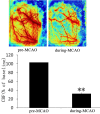Early exercise improves cerebral blood flow through increased angiogenesis in experimental stroke rat model
- PMID: 23622352
- PMCID: PMC3648391
- DOI: 10.1186/1743-0003-10-43
Early exercise improves cerebral blood flow through increased angiogenesis in experimental stroke rat model
Abstract
Background: Early exercise after stroke promoted angiogenesis and increased microvessles density. However, whether these newly formatted vessels indeed give rise to functional vascular and improve the cerebral blood flow (CBF) in impaired brain region is still unclear. The present study aimed to determine the effect of early exercise on angiogenesis and CBF in ischemic region.
Methods: Adult male Sprague Dawley rats were subjected to 90 min middle cerebral artery occlusion(MCAO)and randomly divided into early exercise and non-exercised control group 24 h later. Two weeks later, CBF in ischemic region was determined by laser speckle flowmetry(LSF). Meantime, micro vessels density, the expression of tie-2, total Akt and phosphorylated Akt (p-Akt), and infarct volume were detected with immunohistochemistry, 2,3,5 triphenyltetrazolium chloride (TTC) staining and western blotting respectively. The function was evaluated by seven point's method.
Results: Our results showed that CBF, vessel density and expression of Tie-2, p-Akt in ischemic region were higher in early exercise group compared with those in non-exercise group. Consistent with these results, rats in early exercise group had a significantly reduced infarct volume and better functional outcomes than those in non-exercise group.
Conclusions: Our results indicated that early exercise after MCAO improved the CBF in ischemic region, reduced infarct volume and promoted the functional outcomes, the underlying mechanism was correlated with angiogenesis in the ischemic cortex.
Figures







Similar articles
-
A Short Bout of Exercise Prior to Stroke Improves Functional Outcomes by Enhancing Angiogenesis.Neuromolecular Med. 2019 Dec;21(4):517-528. doi: 10.1007/s12017-019-08533-x. Epub 2019 Apr 2. Neuromolecular Med. 2019. PMID: 30941660 Free PMC article.
-
Pre-ischemic exercise preserves cerebral blood flow during reperfusion in stroke.Neurol Res. 2010 Jun;32(5):523-9. doi: 10.1179/016164109X12581096796431. Epub 2010 Jan 21. Neurol Res. 2010. PMID: 20092679
-
Pre-ischemic exercise reduces matrix metalloproteinase-9 expression and ameliorates blood-brain barrier dysfunction in stroke.Neuroscience. 2008 Jan 24;151(2):340-51. doi: 10.1016/j.neuroscience.2007.10.006. Epub 2007 Oct 18. Neuroscience. 2008. PMID: 18160227
-
Exercise pre-conditioning reduces brain damage in ischemic rats that may be associated with regional angiogenesis and cellular overexpression of neurotrophin.Neuroscience. 2004;124(3):583-91. doi: 10.1016/j.neuroscience.2003.12.029. Neuroscience. 2004. PMID: 14980729
-
Timing is everything: Exercise therapy and remote ischemic conditioning for acute ischemic stroke patients.Brain Circ. 2021 Aug 27;7(3):178-186. doi: 10.4103/bc.bc_35_21. eCollection 2021 Jul-Sep. Brain Circ. 2021. PMID: 34667901 Free PMC article. Review.
Cited by
-
Biomarkers of Angiogenesis and Neuroplasticity as Promising Clinical Tools for Stroke Recovery Evaluation.Int J Mol Sci. 2021 Apr 11;22(8):3949. doi: 10.3390/ijms22083949. Int J Mol Sci. 2021. PMID: 33920472 Free PMC article. Review.
-
Extracellular vesicles contribute to the beneficial effects of exercise training in APP/PS1 mice.iScience. 2025 Jan 4;28(2):111752. doi: 10.1016/j.isci.2025.111752. eCollection 2025 Feb 21. iScience. 2025. PMID: 39898049 Free PMC article.
-
Voluntary exercise ameliorates the good limb training effect in a mouse model of stroke.Exp Brain Res. 2021 Feb;239(2):687-697. doi: 10.1007/s00221-020-05994-6. Epub 2021 Jan 3. Exp Brain Res. 2021. PMID: 33388904
-
Benefits of exercise training on cerebrovascular and cognitive function in ageing.J Cereb Blood Flow Metab. 2021 Mar;41(3):447-470. doi: 10.1177/0271678X20957807. Epub 2020 Sep 20. J Cereb Blood Flow Metab. 2021. PMID: 32954902 Free PMC article. Review.
-
In Search of a Dose: The Functional and Molecular Effects of Exercise on Post-stroke Rehabilitation in Rats.Front Cell Neurosci. 2020 Jun 25;14:186. doi: 10.3389/fncel.2020.00186. eCollection 2020. Front Cell Neurosci. 2020. PMID: 32670026 Free PMC article.
References
-
- Lloyd-jones D, Adams R, Carnethon M. Heart disease and stroke statistics–2009 update: a report from the American Heart Association Statistics Committee and Stroke Statistics Subcommittee. Circulation. 2009;119:480–486. - PubMed
Publication types
MeSH terms
Substances
LinkOut - more resources
Full Text Sources
Other Literature Sources
Medical
Miscellaneous

